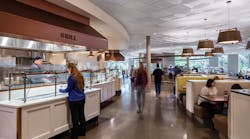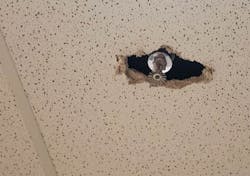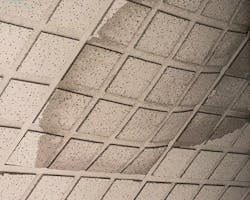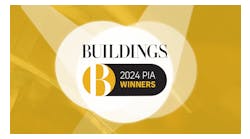The increasing frequency and destructiveness of extreme weather events has put a greater focus on resilience in buildings. The ability to recover from building damage quickly and at minimal cost is vital to the economic survival of owners, tenants, employee occupants and the larger economy of the nation.
For facilities with suspended grid ceilings, it is time to consider the ceiling’s predictable response to extreme events. Ceiling replacements should be made with materials that will perform well in the kinds of events that may be expected in each particular location in order to maximize resilience of the building as a whole.
Standard T-bar ceiling grids, most often made of steel, tend to be fairly resilient under many conditions. They will most likely survive floods or fires unless the fire is so hot that it melts the steel, but in such circumstances, much of the rest of the building may not survive either. Fiberglass grids may be far more vulnerable to fire. Events that move the building violently, such as earthquakes or high wind conditions, could in some cases warp the grid, which would then need to be replaced.
The tiles that populate the grid may be more vulnerable. The most commonly used type, mineral fiber tile, has advantages in some situations and disadvantages in others. For example, they tend to be fire-proof, but may suffer irreversible smoke damage. For locations where mineral fiber tiles pose a risk, there are alternatives such as metal or thermoformed tiles.
When the Earth Moves
Earthquakes are a form of extreme event that have not been worsened by climate change, but they have been occurring more frequently in areas where they were previously very rare; the reasons behind this change are under debate. The response of a ceiling to seismic activity depends greatly on the type of motion, vertical or horizontal, rolling or violent. Where mineral fiber tiles may survive a rolling motion quite well, in violent temblors, they may chip at the edges or crack. Damaged surfaces can release respirable fibers into the air. (Similar considerations apply to buildings that suffer significant movement in high wind conditions.)
In spaces where fire suppression sprinklers protrude through holes in the tiles, ceiling damage can occur because of differential motion. Sprinkler heads are supported by piping that may move at a different speed than the ceiling, causing the sprinklers to wallow out the holes in the tiles.
In such situations, an alternative such as thermoformed tiles that are flexible and less prone to chipping and disintegration are a good choice. Thermoformed tiles are made of rigid vinyl, are lightweight and are available with acoustic control as high as NRC=0.85, making them a viable substitution for mineral fiber in many situations.
Metal tiles would also resist this damage, but they often have razor-sharp edges, which could damage the sprinkler heads or, worse, cause occupant injuries if the motion of the pipes dislodges a tile and causes it to fall out of the grid.
High Water
Flood water not only damages some building materials directly but, with absorbent materials, leaves behind residual wetness that causes mold growth in the flood’s aftermath.
FEMA Technical Bulletin 2 - Flood Damage-Resistant Materials Requirements for Buildings Located in Special Flood Hazard Areas in accordance with the National Flood Insurance Program divides building materials into five classes, depending on their performance when exposed to clean water or flood water. Only Classes 4 and 5 that are “Resistant to floodwater damage” and “Highly resistant to floodwater damage” respectively are acceptable for use on the flood-vulnerable levels of a building.
The guide lists some materials as examples, specifically mentioning “mineral fiberboard” used on walls and ceilings as Class 1, “non-ferrous metals (aluminum, copper, or zinc tiles)” as Class 3 (both unacceptable) and “metals, ferrous” as Class 4. It does not list rigid vinyl ceiling tiles, but they would be considered Class 4, too.
Roof leaks from heavy rain or melting snow can cause sagging and mold problems in absorbent materials and should be taken into consideration in vulnerable locations.
Fire
Even though ceiling materials must comply with fire codes, several considerations remain. Will the ceiling material survive the fire? Will it be reusable? Will it pose a hazard to firefighters?
Metal tiles will predictably survive a fire well unless it is hot enough to melt the metal, more likely with aluminum or copper than with steel. They will not absorb smoke and will likely be cleanable afterwards. Mineral fiber tiles may survive the fire, but will likely absorb smoke and not be cleanable and reusable. Thermoformed tiles are designed to soften, deform and fall out of place in the heat of a fire, allowing them to be used as drop-out ceilings (ceilings that are installed underneath fire sprinklers). They will not burn but will not be re-usable after direct exposure to fire. Thermoformed tiles in parts of a building that does not burn will not absorb smoke and are cleanable, so those will probably be reusable.
Some ceilings may pose a risk to the safety and effectiveness of the firefighters. Mineral fiber tiles do not perform well when wet and can disintegrate and fall on firefighters when they are exposed to water sprays. Drop-out tiles do not burn and do not form a sticky substance on the floor after they drop out, and they are not considered a hazard. Metal tiles have sharp edges and could be hazardous in conditions that make them fall out of the grid, such as a fiberglass grid that may deform under heat or if the tiles are hit by high-pressure water spray.
Conclusion
Selecting a resilient ceiling requires assessment of the extreme events that may be possible in its particular location and the risks that may be posed in each specific building. In some cases, there may be multiple risks. Careful consideration of the possibilities, and acknowledgement that the level of risk from some kinds of events is continuing to increase, will guide the choice of a resilient ceiling, as well as other resiliency features of the facility that need to be addressed.



